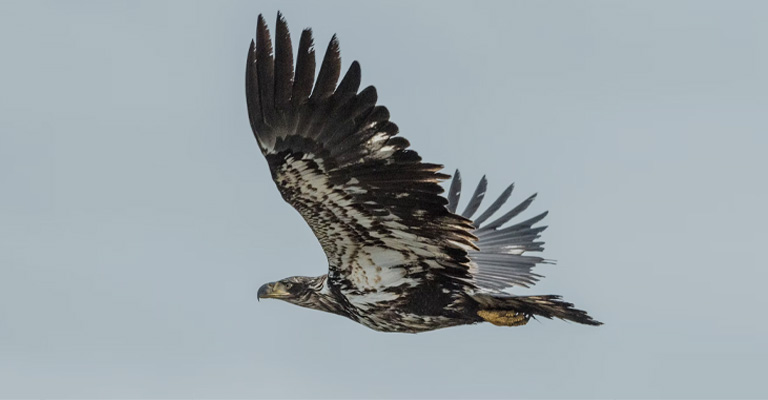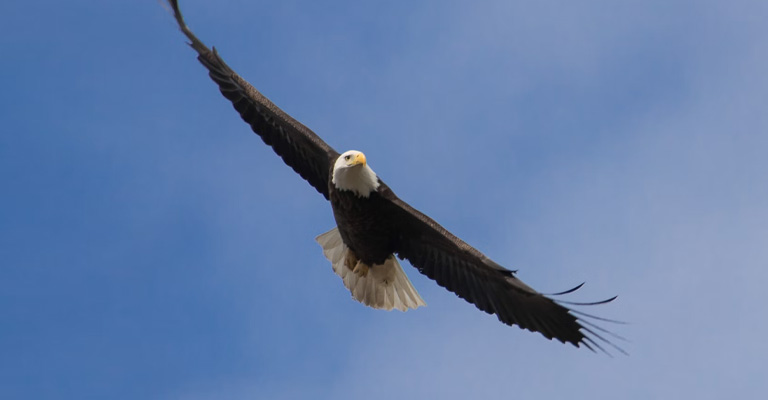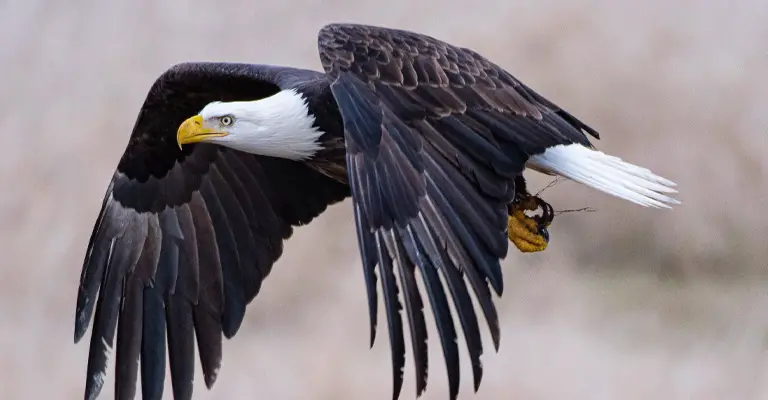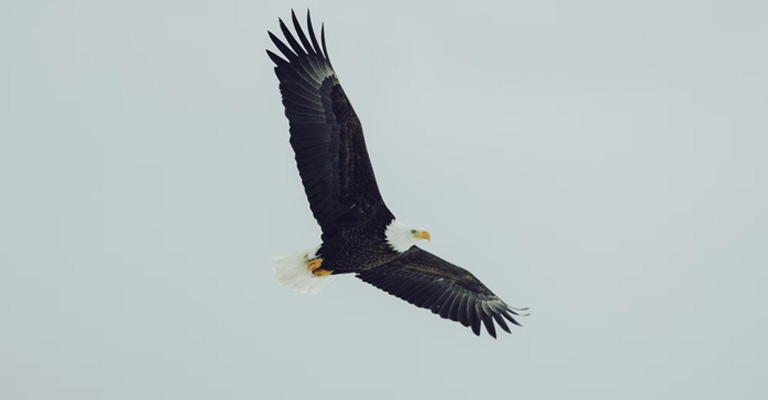The sight of an eagle soaring through the turbulent tempest of a storm is a testament to the avian mastery of the skies.
The question “How do eagles fly in a storm?” invites us to explore the awe-inspiring world of these apex predators and their remarkable adaptability to the harshest weather conditions.
As fierce hunters and guardians of their territories, eagles are frequently faced with the choice of navigating through storms for various reasons, from territorial disputes to seeking shelter or hunting opportunities.
Their strategies for conquering the elements are a mesmerizing blend of aerial skills, navigational wisdom, and an indomitable spirit.
The eagle’s flight in a storm is a display of nature’s ultimate fliers defying adversity, and this exploration takes us into the heart of their airborne resilience.

How Do Eagles Fly In A Storm?
Flying in a storm presents a formidable challenge for eagles and other birds of prey. However, their adaptations and strategies allow them to navigate through inclement weather.
Here are some ways eagles fly in a storm:
Soaring Above the Storm
Eagles often ascend to higher altitudes before a storm hits, allowing them to ride the upper air currents and thermals. This strategy keeps them above the turbulent lower atmosphere, where the worst of the storm’s effects occur.
Flapping Flight
In moderate winds, eagles may use flapping flight to manoeuvre through the storm. They have powerful wings and muscles, enabling them to maintain control and stability during flapping flight in strong winds.
Gliding
Eagles are skilled gliders, and during a storm, they may use gliding flight to conserve energy while moving within their territories or attempting to reach shelter.
Holding Position
In the face of strong winds, eagles may tuck their wings and hold a stationary position in the sky. This reduces energy expenditure and minimizes the risk of being carried off course by the wind.
Finding Shelter
When storms approach, eagles often seek shelter in natural features such as cliffs, trees, or ledges. These locations provide protection from the worst of the weather and allow them to ride out the storm in relative safety.
Navigating Around the Storm
If possible, eagles may opt to circumvent a storm rather than flying directly through it. They use their keen instincts and knowledge of local weather patterns to make this decision.
Territorial Protection
In some cases, territorial disputes between eagles can intensify during or after a storm. Competing eagles may engage in aerial confrontations to assert their territorial boundaries.
Eagles employ a combination of flight strategies and behavioural adaptations to cope with storms, ensuring their safety and survival in challenging weather conditions.
Their mastery of the skies enables them to weather even the fiercest of natural tempests.
Flying Tactics Of Eagles To Fly In A Storm

Eagles are exceptional aviators and employ a range of tactics to navigate and survive while flying in a storm. Here are some flying tactics they use:
Altitude Adjustment
Before a storm, eagles often adjust their altitude. They soar to higher altitudes, riding the upper air currents and thermals, which are less turbulent.
This altitude adjustment allows them to stay above the worst of the storm’s effects, where wind and turbulence are less severe.
Gliding and Soaring
Eagles are masters of gliding and soaring flight, and they use these tactics to conserve energy while navigating through a storm.
Gliding involves using rising air currents to stay aloft with minimal effort while soaring takes advantage of wind gradients to maintain altitude.
Tucking Wings
In the face of strong winds, eagles can tuck their wings and enter a stationary position in the sky. This tactic minimizes energy expenditure and reduces the risk of being carried off course by powerful gusts.
Dynamic Flight Adjustment
Eagles dynamically adjust their flight pattern in response to changing wind currents. They use a combination of flapping, gliding, and soaring to maintain control and stability in varying wind conditions.
Navigational Expertise
Eagles possess an innate understanding of local weather patterns, and they use this knowledge to navigate around storms when possible. They may choose alternative routes to avoid the worst of the weather.
Seeking Shelter
When a storm approaches, eagles often seek shelter in natural features like cliffs, trees, or ledges. These locations provide protection from wind, rain, and hail, allowing them to ride out the storm while minimizing exposure.
Territorial Protection
Some storms can intensify territorial disputes among competing eagles. Eagles may engage in aerial confrontations to assert their territorial boundaries, especially when their nesting sites or food sources are threatened.
These tactics collectively showcase the adaptability, intelligence, and resilience of eagles in the face of challenging weather conditions. Their mastery of the skies allows them not only to survive storms but also to continue their essential ecological roles as apex predators.
Why Do Eagles Fly In A Storm?

Eagles’ decision to fly in a storm is driven by various factors, reflecting their adaptability to challenging conditions. Here are some reasons why eagles may choose to fly in a storm:
Navigational Necessity
Eagles may find themselves in a storm unintentionally due to their migratory routes or hunting territories. Navigational necessity can force them to continue flying through the storm in their quest for food or while on a migratory journey.
Territorial Defense
Storms can trigger territorial disputes between eagles. Competing birds may engage in aerial confrontations during or after a storm to assert and protect their territories.
Maintaining control over a specific territory is vital for securing access to resources and breeding sites.
Hunting Opportunities
Storms can lead to an influx of prey washed into water bodies. Eagles, especially fish-eating species, might fly into storms to take advantage of the increased hunting opportunities presented by disoriented or weakened fish.
Migration Challenges
Eagles, particularly migratory species, may encounter storms during their seasonal journeys. They often continue flying to reach their destinations, find food, or avoid unfavourable conditions elsewhere.
Weather Variability
Not all storms are severe, and eagles may tolerate milder weather disturbances. They adapt to variable weather conditions and use their flight abilities to navigate through minor storms without major disruptions.
Habitat Needs
Eagles may be searching for specific habitat features like cliffs or sheltered areas. In such cases, they may need to fly through a storm to reach these critical locations, which offer protection or nesting opportunities.
Migratory Rest Stops
During migration, eagles might make unplanned stops in response to weather conditions. Storms can provide temporary shelter and resting places. While not ideal, these rest stops allow eagles to recover energy before continuing their journey.
Eagles’ decisions to fly in a storm are influenced by a complex interplay of ecological and behavioural factors, reflecting their remarkable adaptability to the ever-changing natural world.
Whether it’s for food, territory, or migration, eagles employ their aerial prowess to endure and thrive amidst challenging conditions.
What Other Birds Can Fly In A Storm?

Many bird species possess the adaptability and resilience to navigate through storms. Here are some birds that can fly in a storm:
Albatrosses
Known for their incredible oceanic journeys, albatrosses are skilled at flying in storms over vast seas. They have immense wingspans and are well-equipped to handle the challenges of strong winds and rough waters.
Petrels
Various species of petrels, such as the Southern Giant Petrel, are highly adept at flying in storms. These seabirds can ride the strong winds and turbulent seas, often scavenging for food during storms.
Frigatebirds
Frigatebirds are known for their ability to remain aloft for extended periods, even in adverse weather conditions. They are exceptional at soaring high above the ocean and can weather storms while foraging for food.
Penguins
Penguins are agile swimmers but also capable of flying through stormy weather. They use their strong flippers to navigate through rough seas while searching for prey.
Shearwaters
Shearwaters are seabirds known for their graceful flight. They can ride the strong winds and waves of storms, often foraging for fish and other marine creatures amidst turbulent waters.
Swans
Migratory swan species, such as the Tundra Swan, are capable of flying in stormy conditions during their long-distance journeys. They can endure strong winds and precipitation while migrating.
Gulls
Gulls are versatile and adaptable birds often found near coastal areas. They can fly in storms, making the most of turbulent weather conditions to scavenge for food along the shorelines.
These birds exhibit a remarkable ability to cope with the challenges posed by storms, whether at sea or in other habitats. Their resilience and flying skills allow them to thrive in environments that might be inhospitable to less adaptable species.
FAQs
How do eagles remain airborne during a storm?
Eagles employ their remarkable flying skills to navigate storms. They often ascend to higher altitudes before the storm, riding thermals and upper air currents that are less turbulent.
At these altitudes, they minimize the impact of turbulent weather and strong winds on their flight.
How do eagles manage to stay on course during a storm?
Eagles use their extraordinary navigational abilities and knowledge of local weather patterns to adapt their flight paths. They may adjust their routes to circumvent the worst of the storm or continue through if conditions permit.
Their innate sense of direction helps them stay on course despite changing weather.
Do eagles use different flight techniques in a storm?
Yes, eagles dynamically adjust their flight tactics in response to storm conditions. These tactics may include gliding and soaring to conserve energy, tucking their wings to maintain stability, and utilizing a combination of flapping, gliding, and soaring for control.
What is the role of altitude in eagle flight during a storm?
Altitude is crucial for an eagle’s flight in a storm. They soar to higher altitudes to ride upper air currents, avoiding the worst turbulence of the storm. This allows them to remain above the most severe weather conditions and reduce the impact on their flight.
How do eagles find shelter during a storm?
Eagles often seek natural shelters, such as cliffs, trees, or ledges, to ride out storms. These locations offer protection from the wind and precipitation. By finding suitable shelter, eagles can minimize exposure to the elements and remain relatively safe during the storm.
Conclusion
Eagles’ flight in a storm is a poignant metaphor for nature’s enduring will to thrive, even when faced with the most formidable challenges.
From soaring above tempests to navigating turbulence, eagles demonstrate the extraordinary fusion of physical prowess and behavioural adaptability.
Their mastery of the skies allows them to endure and sometimes even thrive amidst the chaotic forces of nature.
The eagle’s flight in a storm serves as a reminder of the remarkable balance of life and the intricate web of ecological relationships in which these magnificent birds play an irreplaceable role.
Their survival amidst the chaos of a storm reminds us of the unyielding resilience of life itself.